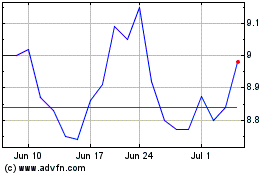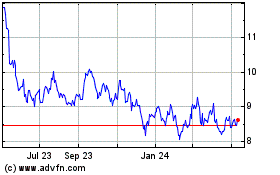MUMBAI—A wave of foreign money is helping put Indian stocks
among the world's best performing this year, with investors
confident the market can withstand any reversal of this year's
global rush into emerging-market equities.
The benchmark S&P BSE Sensex is up 8.3% so far this year,
and is now less than 5% below its all-time closing high set in
January 2015. Among major emerging markets, Brazilian and Russian
stocks have performed better—but both are rebounding from three
years of losses.
The fever for Indian stocks is evident from the country's
booming initial public offerings. Last week's $900 million float of
ICICI Prudential Life Insurance Co., an Indian insurance company,
was the country's largest in six years—yet it was oversubscribed by
10 times.
Overseas investors have caught the bug: Around $7 billion of
foreign money has flowed into the Indian market this year, up from
$4 billion over the same period in 2015, according to regulatory
data.
That could leave India vulnerable if the "global search for
yield" goes into reverse, the trend by which investors have scoured
the world for higher returns. Some fear any future series of rate
increases by the U.S. Federal Reserve could trigger such a
reversal. On Monday, the Sensex fell 1.3%, in line with other Asian
markets.
But investors and analysts say India—where annual growth reached
7.5% in the first half of 2016, beating China's 6.7%
expansion—could eventually prove better placed than other emerging
markets if global capital flows turn. They cite factors including
government reforms under Prime Minister Narendra Modi as reasons to
remain optimistic.
"India is in a Goldilocks situation," which is attracting global
investors, said Sumit Jalan, co-head of investment banking at
Credit Suisse in India. "Foreign investors are driving [Indian]
markets."
Once lumped in with a block of emerging markets termed the
BRIC—Brazil, Russia, India and China—India has lately diverged from
the group, in part thanks to its heavy weighting toward domestic
consumption. By contrast, Brazil and Russia have been hit by the
slump in global commodity prices, while China's exports have
suffered from a slowdown in world trade.
Over the past three years, Indian shares have gained a
cumulative 44%, beating the 37.5% rise in China's Shanghai
Composite, and well ahead of the 8% rise in Brazilian shares and
the 31% drop in Russia.
India's inflation has eased, its trade deficit has narrowed
thanks to lower oil prices, and the rupee has been relatively
stable against the U.S. dollar this year. Recent good monsoon rains
could help boost agricultural productivity, and thus consumer
demand from rural India.
India's government has delivered on some planned reforms:
Parliament this year approved a long-pending bill to replace myriad
federal and state taxes with a national goods-and-services tax. It
also cleared a new bankruptcy law which could make it easier to
wind up a failing business.
Some reckon investors will continue to differentiate India from
other leading emerging markets, in the belief that Indian consumers
would keep buying new cars, televisions and mobile phones. Shares
of consumer-goods companies, auto makers, banks, and cement
companies have risen sharply this year, with some gaining as much
as 60% in recent months.
"They're all very clear: India is the stable part of my
portfolio, I keep it. The rest I'm trading around," said Bharat
Iyer, head of equity research at J.P. Morgan in India.
"Things look aligned for a fairly sustainable cycle for India
going forward," said Matthew Dreith, a fund manager at U.S.
money-management firm Wasatch Advisors, which has $6.8 billion
invested in emerging markets. Its allocation to India has increased
to $1.2 billion over the past two years.
With a market capitalization of more than $1.6 trillion each,
India's main stock exchanges—BSE Ltd. and the National Stock
Exchange—now rank 10th and 11th in the world, respectively,
according to the World Federation of Exchanges. Only around half of
the listed stocks is available for purchase by investors, since
company founders often hold the majority of their shares. Foreign
investors own around one-quarter of all shares issued by India's
top 200 companies.
One concern is that Indian stocks have become overvalued. The
Sensex currently trades at around 18.5 expected company earnings
for the year ending March 2017, above its 15.5 times long-run
average forward price-to-earnings ratio, according to local
brokerage Sharekhan Ltd.
Still, analysts believe that higher profits will justify the
high valuations. J.P. Morgan said it expects profits for companies
in the benchmark Nifty 50 index to rise by 8% to 10% for the
financial year ending March 31, 2017, and by 15% in 2018.
Indian companies are capitalizing on investor demand by
launching a flurry of new equity issuance. While IPO issuance has
fallen this year globally, total deal values in India have nearly
tripled to $2.8 billion, according to Dealogic. Bankers say other
large flotations in the coming year include those for the Indian
unit of U.K. mobile-phone company Vodafone Group PLC, and India's
largest securities exchange, the National Stock Exchange of India
Ltd.
Write to Shefali Anand at shefali.anand@wsj.com and Debiprasad
Nayak at debi.nayak@wsj.com
(END) Dow Jones Newswires
September 26, 2016 08:35 ET (12:35 GMT)
Copyright (c) 2016 Dow Jones & Company, Inc.
Vodafone (NASDAQ:VOD)
Historical Stock Chart
From Aug 2024 to Sep 2024

Vodafone (NASDAQ:VOD)
Historical Stock Chart
From Sep 2023 to Sep 2024
